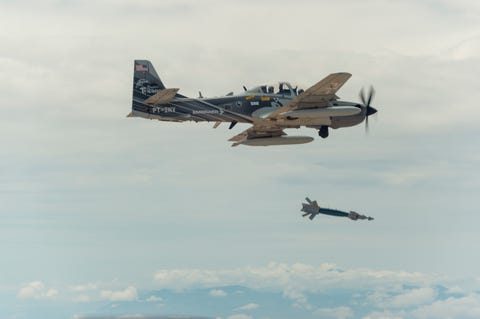Read the full Popular Mechanics story here.
Air Force Secretary Heather Wilson says the service is overtaxed for its many missions around the globe and needs more manpower by 2030.
By Kyle Mizokami
Popular Mechanics
The U.S. Air Force is too small. That’s the word from Secretary of the Air Force Heather Wilson, who today called for the USAF to add 40,000 more personnel and 74 more squadrons by 2030 to cope with missions from Korea to Afghanistan while gearing up for big power conflict with countries like Russia or China.
Growth won’t be cheap however. One expert estimated the annual costs at nearly $20 billion, and that’s not including new aircraft and equipment.
- Wilson, while giving the opening speech at the annual Air Force Association conference, clearly spelled out what the service thinks it needs to accomplish all of the missions assigned to it. The additional force breakdown is as follows:
- 22 more C2ISR (Command, Control, Intelligence, Surveillance, & Reconnaissance) squadrons
- 14 more tanker squadrons
- nine more combat search and rescue squadrons
- seven more special operations squadrons
- seven more fighter squadrons
- seven more space squadrons
- five more bomber squadrons
- two more drone squadrons
- one more airlift squadron
The Air Force currently operates 312 squadrons, down from the 401 squadrons operational at the end of the Cold War. Wilson’s increase would bring the service back up to 386.
The force breakdown reflects the changing nature of warfare. The Air Force wants to increase its number of sensors–specialized aircraft designed to collect intelligence on the battlefield—to provide accurate intel targeting data to the “shooters”—the fighters, bombers, and unmanned aerial vehicles. With that also comes an expansion in the number of command and control platforms designed to take intel and turn it into an actionable list of threats and targets.
The Air Force also wants to grow its number of aerial refueling tankers, in order to conquer the vast distances involved in crossing the Pacific Ocean, the Middle East, and Western Europe. Anti-ISIS plans and contingency operations against North Korea could play a role in this move, but there’s no doubt that uncertainty about Russia and China is driving expansion of the Air Force’s tanker fleet. The range from Kadena Air Base on Guam to the Chinese mainland, for example, is 1,945 miles. From Guam to North Korea is 2,100 miles, and from bases in the U.K. to Russian naval bases north of the Arctic Circle the distance is 1,700 miles.

Credit Ethan Wagner, U.S. Air Force
The Air Force also wants five more bomber squadrons, which is a difficult task at the moment as there are no new heavy bombers in production. The new B-21 Raider bomber is set to enter production in the mid-2020s. One hundred Raiders will replace 20 B-2 Spirit bombers and 60 B-1B Lancer bombers, so an increase of five bomber squadrons could mean the service has more Raiders in mind.
The Air Force also only wants seven new fighter squadrons. The F-35 is the only fighter currently in production, but the service has warned it could cut the number of F-35s it buys by a third unless it gets operating costs down. So, an increase in the number of F-35s seems unlikely for now. The service is considering purchasing up to 300 observation-light attack (OA-X) aircraft, and that might explain what will equip those new squadrons.
Meanwhile, a bigger Air Force requires more search and rescue squadrons. CSAR squadrons do everything from rescue civilian hikers in peacetime to rescue pilots of downed aircraft in wartime, and nine new combat search and rescue squadrons is a significant boost. CSAR squadrons typically employ HC-130J Combat King II transports and HH-60G Pave Hawk helicopters to conduct rescues on land and sea, during peacetime and under hostile fire.
Interestingly, the Air Force seeks seven new space squadrons. Space squadrons control friendly space assets while monitoring those of potential adversaries. These could be spun off into the new Trump Space Force, if that ever becomes a reality.
How much will all of this cost? We don’t know how many and what kind of aircraft the Air Force will buy, but it will include one-time purchase costs in the billions. Long term, Todd Harrison, an analyst at the Center for Strategic and International Studies pegged annual personnel costs for 40,000 new airmen at $5.2 billion, and a projected increase in operations costs of around $13 billion, for a total annual increase of approximately $18.2 billion annually.
